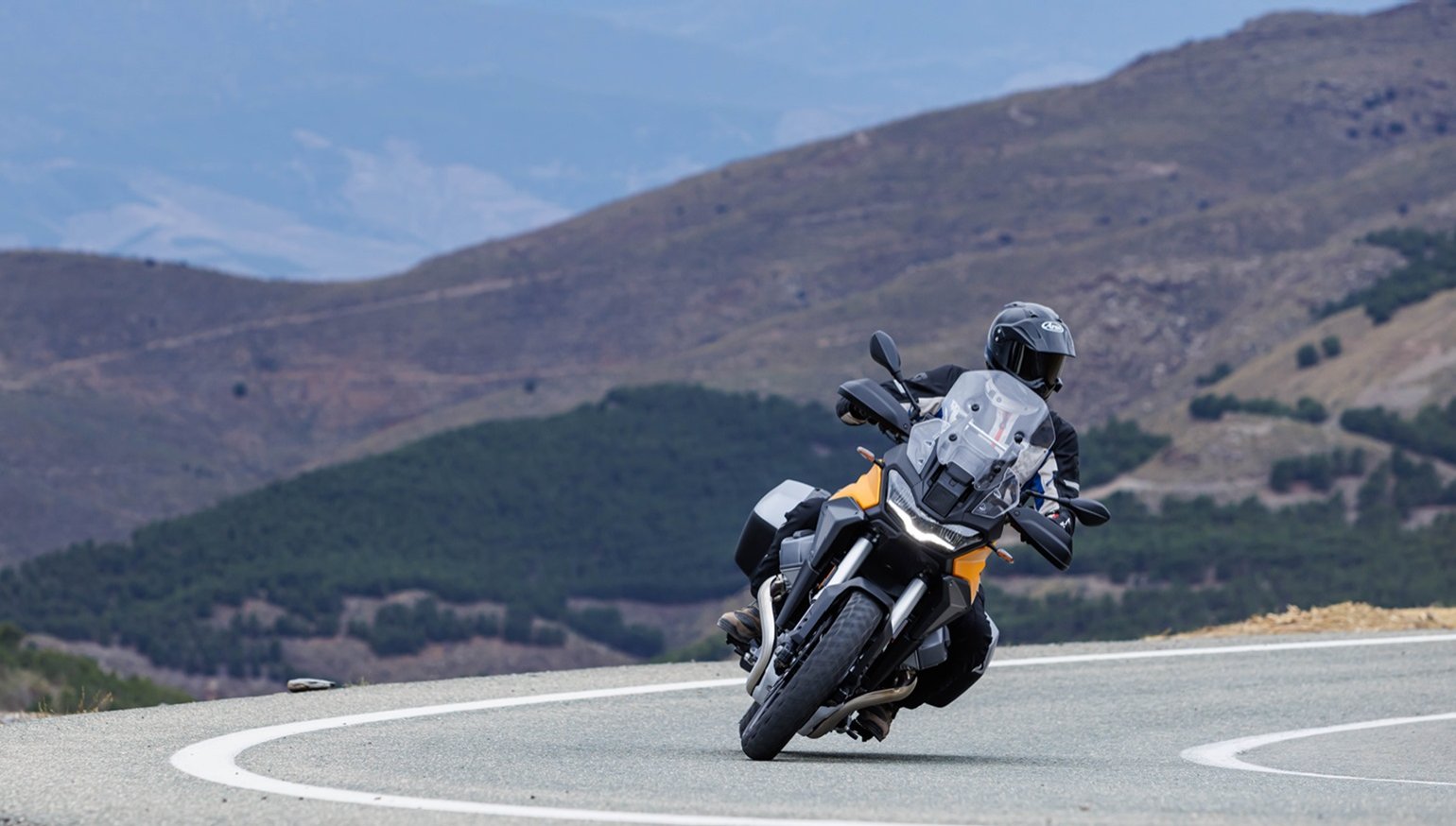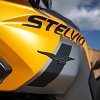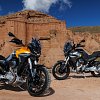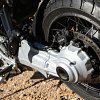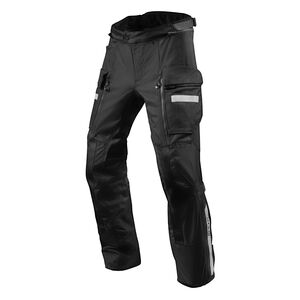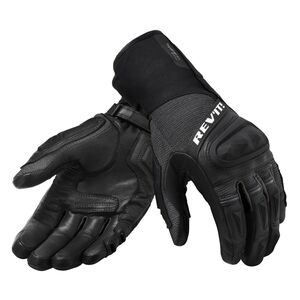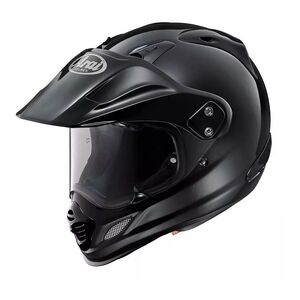Fresh off its 100th anniversary celebration, Moto Guzzi is in the middle of a renaissance.
Two years ago, the Italian company generated headlines with the introduction of the V100 Mandello, a sport-tourer featuring an all-new “compact block” V-twin engine and unexpected levels of technology (including the first active aerodynamics on a production motorcycle). The party continues with a new adventure-touring model that brings back a name from the past — Piaggio's (Moto Guzzi's parent company) PR Manager Fabio Gilardenghi calls it "the second act of a new range of bikes." Meet the 2024 Moto Guzzi Stelvio.

Adding adventure
The man who styled Guzzi's two latest motorcycles is Senior Designer Giulio Rossi Paccani. Speaking about his most recent creation, he says that the "Stelvio keeps some of the distinctive traits of the Mandello, evolving toward the dimension of all-around capability."

Let's look at what Guzzi did to turn the all-arounder into an adventure-tourer, starting with the drivetrain. The core of the 1,042 cc "compact block" V-twin, which debuted in the Mandello, remains the same, so you can expect a claimed 115 horsepower at 8,700 rpm and 77.4 foot-pounds of torque at 6,750 rpm, with 82% of the latter available at 3,500 rpm. The engine is now Euro5+ compliant and the cylinder heads were rotated by 90 degrees and the cylinders are canted forward by five degrees compared to the previous "small block" motor to help maximize legroom. Guzzi says the spark plug covers were blacked out to "emphasize the sturdiness" of the Stelvio.
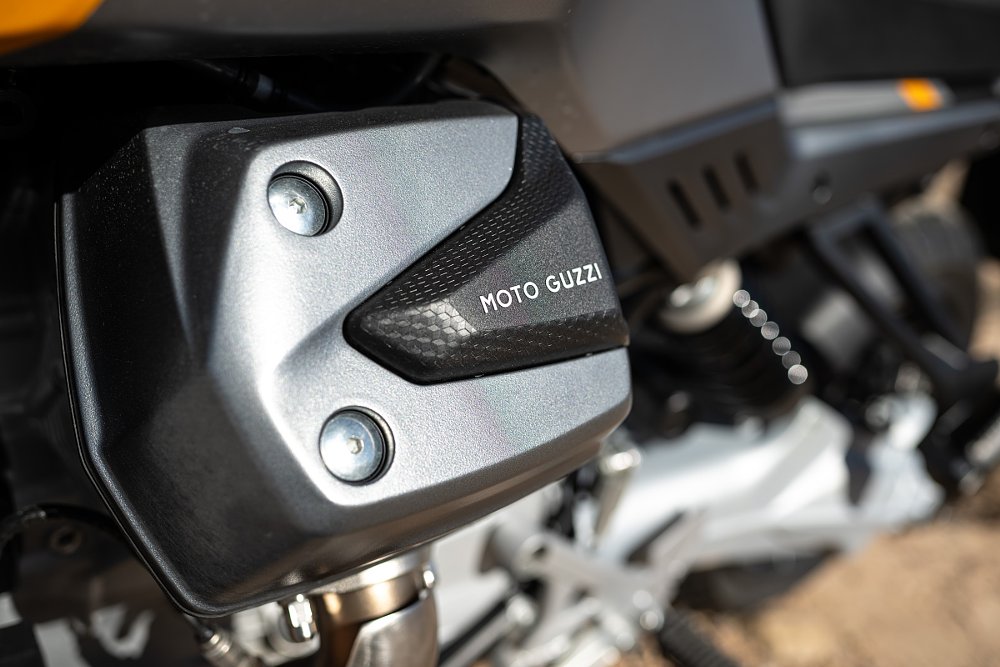
The motor is paired with a hydraulically operated assist and slipper clutch that sends power to a six-speed transmission via a shaft final drive. In response to some negative feedback regarding shifting on the Mandello, MG has revised the gear-shifting mechanism, the gears themselves, and quickshifter calibration on the Stelvio. Certain components have been beefed up: The drivetrain is now connected to the frame with four front mounting points as opposed to two, and said frame is 20% stiffer than what's in the Mandello. The swingarm attachment is stiffer and the shaft drive cover thickness increases from five millimeters to seven millimeters.

The trend of larger numbers continues with the suspension, which is now comprised of a 46 mm (versus 41) Sachs inverted fork and a KYB shock. Both ends feature adjustment for preload (with a remote adjuster on the rear) and rebound damping (not compression damping) and 170 mm of travel. The shock has 20 clicks of preload adjustment available and the default position is seven. Yours truly had saddlebags equipped, and Guzzi's representatives fed in an additional three clicks of preload to compensate.
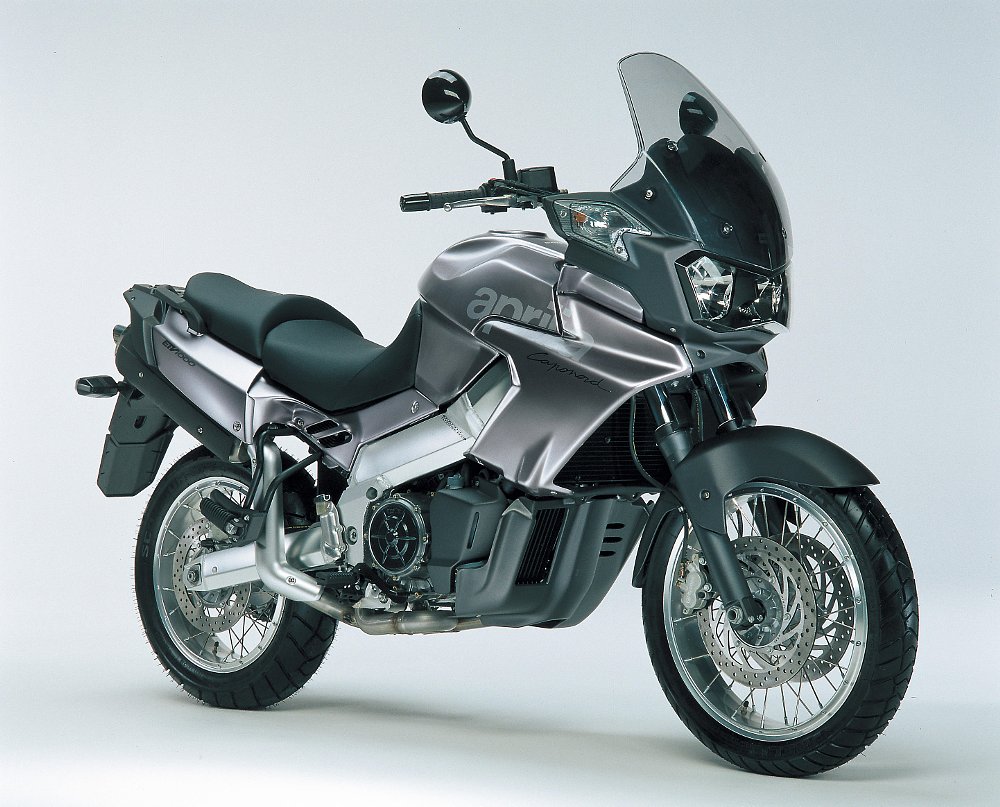
Riding impressions
Swinging my leg over the 32.7-inch-tall seat for the first time, my first thought was that the Stelvio was more of an Aprilia than a Moto Guzzi. The controls, mirrors, master cylinder reservoirs, even the dash are from Aprilia models like the RSV4. This is not a bad thing. Amusingly (at least to me), the new headlight even looks like what was used on the first generation of the Aprilia Caponord.
But as soon as you fire it up, the Guzzi-ness is evident. The familiar side-to-side rocking motion from the motor will be heartwarming to Guzzi fans, though (thanks to a counter-rotating crankshaft) it's mellowed out compared to the air-cooled unit in a V7 or a V85. Our ride started in beautiful Almería on the southeastern coast of Spain, and we had to spend a little bit of time putting around the city before getting on the highway with the eventual goal of conquering some mountain passes. That meant I started the day in Road mode, one of five riding modes the Stelvio offers.
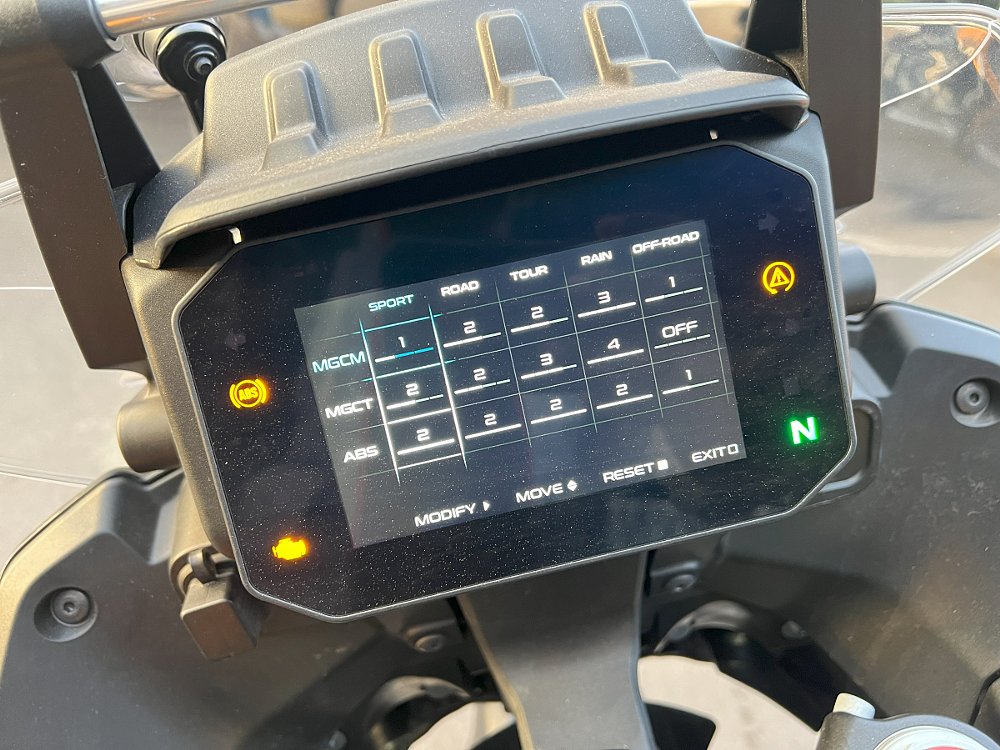
I pulled the clutch in, shifted into first, and was not pleased to hear a loud clunk while the whole bike inched forward with surprising gusto. Over the course of the day, I learned that experience would not be a one-off. The quickshifter is a tale of two directions. Downshifts are excellent across a variety of gears and speeds, but upshifts vary dramatically. Using the quickshifter to go from first to second or second to third was an exercise in frustration — sometimes it was fine, but there were frequently instances of slow shifts and/or bad mapping that compelled me to go back to using the clutch. Shifting normally is an enjoyable experience, and the Brembo clutch master cylinder provides good feel.
My colleagues on the ride who had experience with the Mandello said that the new quickshifter was actually an improvement but I still found it to be one of the worst I've used in recent memory. It's one of the few low spots of the Stelvio.
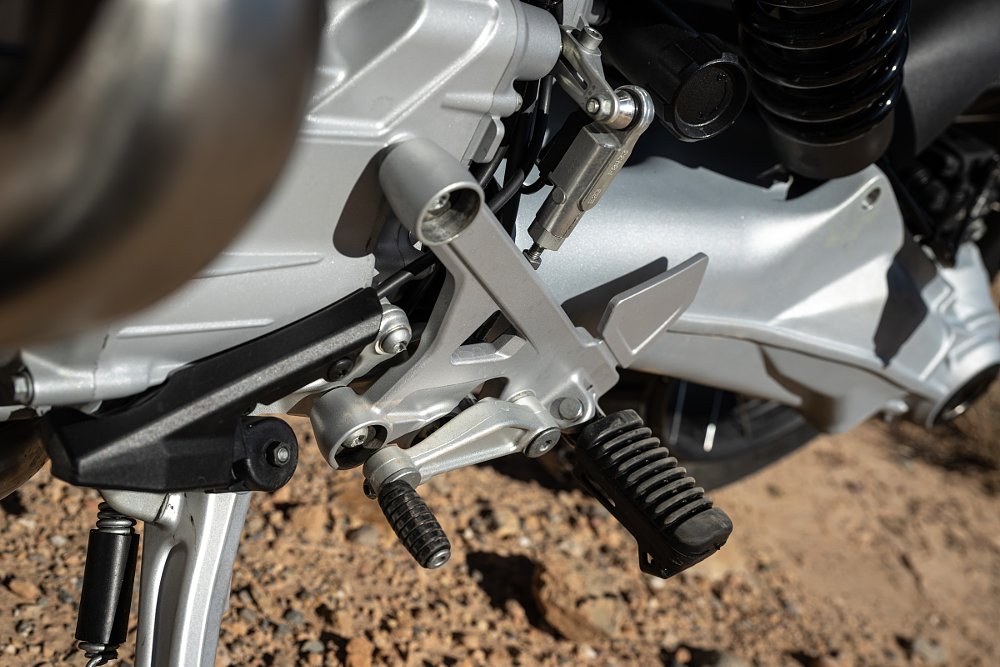
In first or second gear, if you have the throttle cracked open just a tiny bit to maintain slow speeds in traffic, you sometimes get a little surging or a bit of a hiccup. Everywhere else, it's totally fine, and at higher speeds the Stelvio is an absolute joy: It's incredibly stable, there's barely any vibration, and the upright ergonomics are fantastic. At these speeds, the flexibility of the V-twin engine shines. Between 3,000 and 7,000 rpm is the sweet spot but it doesn't fall flat on its face when you rev it out. You always feel like there's enough power to push you forward with smile-inducing thrust. Part of this is due to the gear ratios, which border on the edge of being too close for a touring bike. Still, if you're following an Italian ride leader who decides to turn up the wick on the highway, it turns out that the Stelvio is happy to cruise at higher speeds as well.
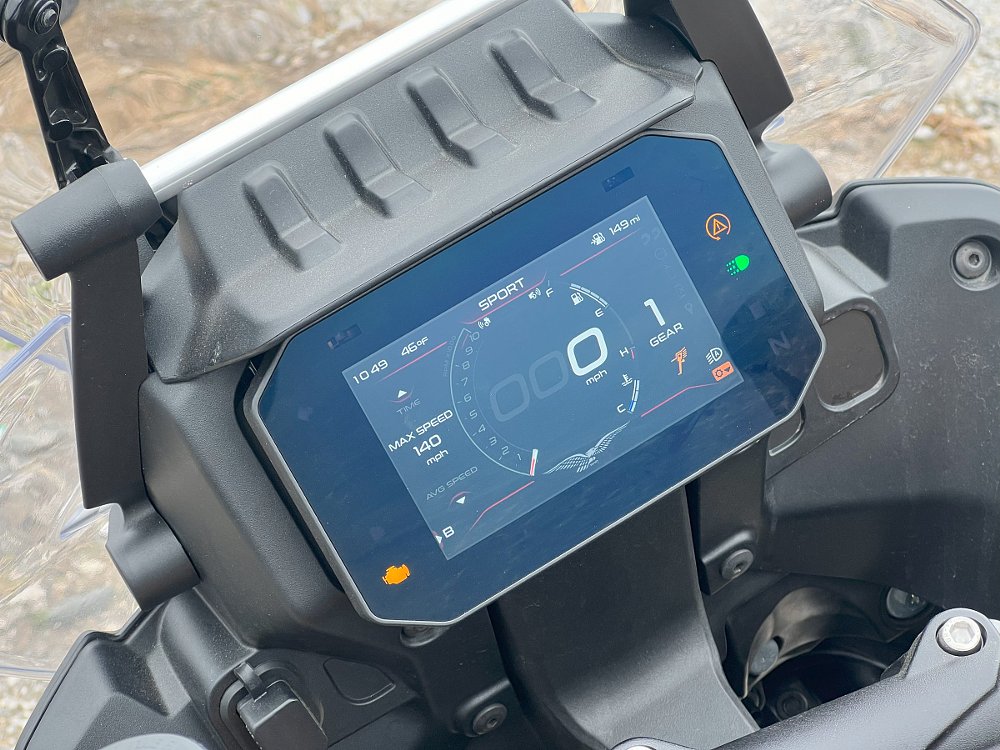
If you're the kind of person who likes riding at triple-digit speeds, you should know that the electrically adjustable windshield will not allow for changes if you're going faster than 93 miles per hour (150 km/h). Below those speeds, you'll find that there's 2.75 inches of adjustment. I am six feet, three inches tall and I found that in the lowest setting, wind was sent to the middle of the visor on my Arai XD-4 helmet. In the highest setting, wind was sent right to the helmet's peak. Riders of my height should look into the accessory touring screen for a bit more protection, or keep the windscreen in the lower settings to clean up air flow to the head.
Protection on the torso, knees, and arms is quite good. Moto Guzzi says that more than 1,500 hours of computational fluid dynamics simulations went into shaping the Stelvio's bodywork to cover riders varying between the fifth and 95th percentiles in height. In their models, the average rider was five feet, 11 inches tall with a passenger five feet, seven inches tall.
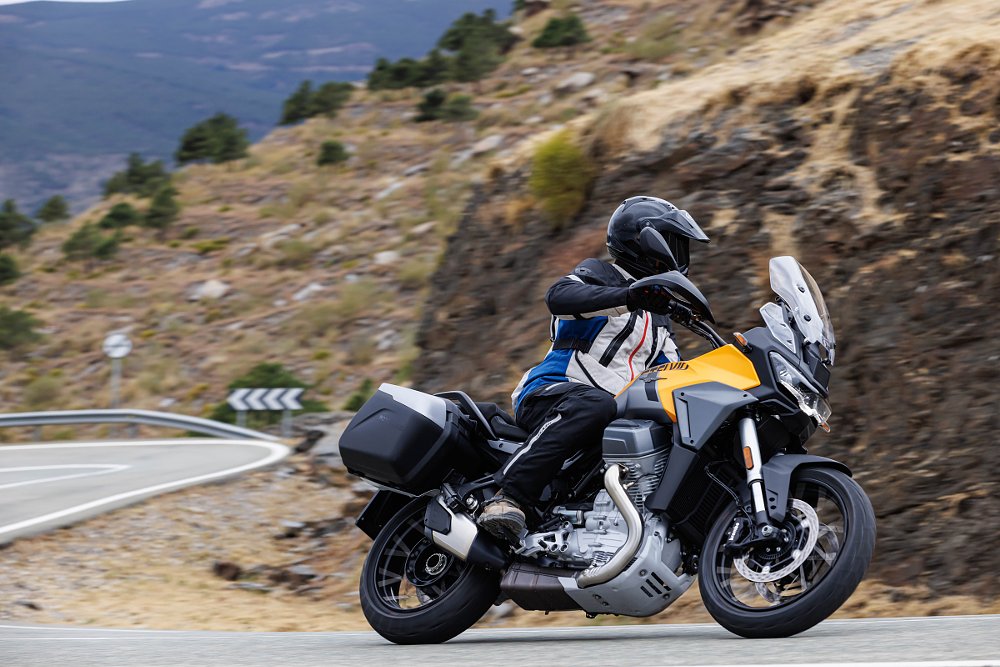
We exited the highway to tackle some local mountain passes so I lowered the windshield and switched into Sport mode. I'm excited to say the Stelvio also excelled here — any concerns about whether the ADV-flavored changes would ruin the handling were unfounded. Despite the 19-inch front wheel, taller suspension, and increase in weight, this bike handles much better on pavement than I expected. In fact, some of the changes that were made for adventure purposes (namely the additional engine mounts and chassis reinforcements) make the frame stiffer and quite enjoyable out on the road.
The suspension is also on the stiffer side and it was well set up to handle 542 pounds of bike on tight, twisty mountain roads. I did not think it was lacking for how most customers will ride this bike, though it's fair to wonder why there isn't an option for Öhlins adaptive suspension, like the Mandello got. When asked about this at the media briefing, Guzzi's representatives stated that they didn't see a need (and they're probably right) but that they will add it if the market demands it. Maybe there will be a Stelvio S in the future?
A wide handlebar gives you good leverage and the Stelvio responds very well to trail braking, which I frequently required through the switchbacks of southern Spain. The 80/20 Michelin Anakee Adventure tires are capable enough of holding grip until past the point of having the peg feelers touch ground.
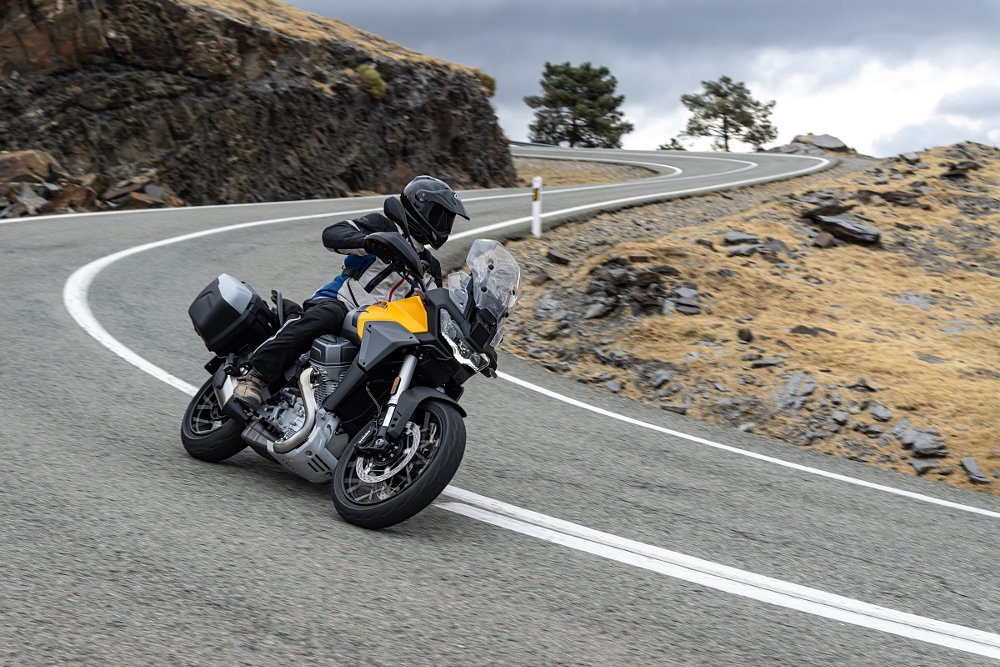
Brembo supplies the master cylinder and calipers, though the latter are older generation M4.32 calipers, which were introduced back in 2012. Still, I don't have any complaints about their performance, at least as a solo rider. Maximum payload is 463 pounds, and if I had a passenger and full bags, I would have wanted a little more initial bite.
One of the passes we rode on was Alto Velefique, and it was a fitting road for us as it is known as the "Spanish Stelvio" by local cyclists. The temperature went down as the elevation went up. Eventually we found ourselves 6,200 feet high and the temperature gauge on the Stelvio said 40 degrees Fahrenheit. The reassurances of traction control and cornering ABS meant I didn't have to back off too much with the colder road temperatures but I no longer felt a need to push too hard — the Guzzi had already proven itself to be a fantastic road bike.
Questions about the Stelvio's off-road performance are probably best answered with the note that Guzzi had us ride the bikes off-road for less than a mile as part of the test route.
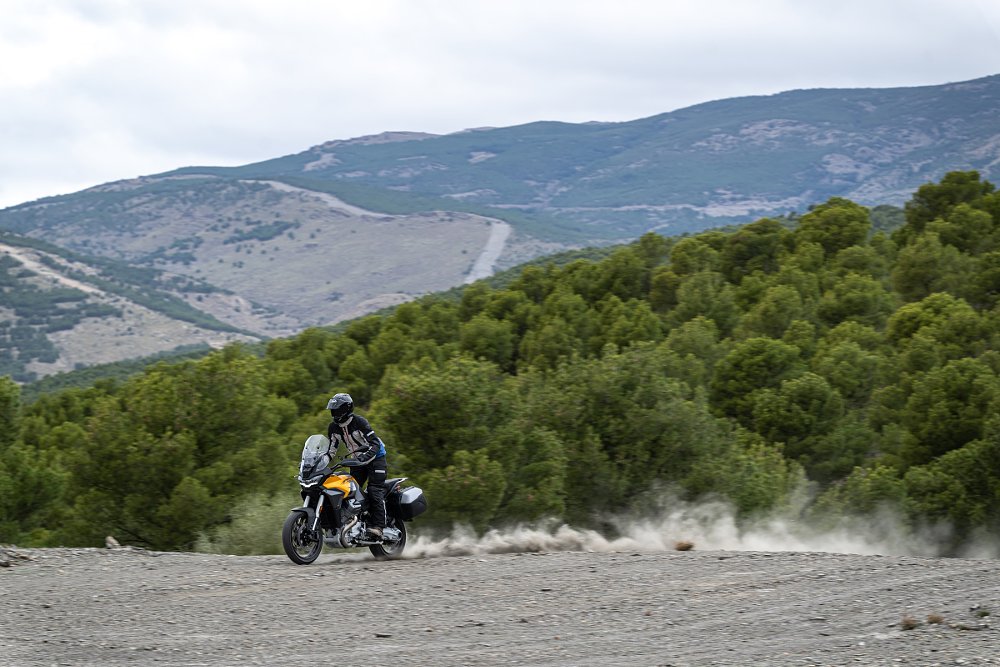
The short version is that the Stelvio is much more at home on pavement than off. Even in our brief dirt sojourn it was easy to find the limits of the suspension, and it feels a little top-heavy (try to avoid parking it on an incline). I wouldn't recommend the average rider take it on anything beyond a fire road, and if you're looking for more than that, the Piaggio group will gladly sell you an Aprilia Tuareg, instead.
After our day of riding and photo stops, there was plenty of range left in the Stelvio's 5.5-gallon tank. Moto Guzzi claims 46 miles per gallon and based on my experience I'd say that's easily attainable if you ride at a normal pace. A little bit of multiplication reveals that the tank is good for 253 miles at the claimed mpg.
Moto Guzzi is asking U.S. buyers to shell out $16,390 plus $650 in freight for the new Stelvio, which puts it right in the middle, cost-wise, between Japanese offerings like the Suzuki V-Strom 1050 and Honda Africa Twin Adventure Sports and Euro offerings such as the Ducati Multistrada V2 and BMW R 1300 GS. It slots in correspondingly from a performance standpoint and it could be a good Goldilocks bike for riders who don't need 170 horsepower from a touring motorcycle. With that said, at this price point, I'm surprised that there's no compression damping adjustment in the suspension and it really should have heated grips as standard. Instead, they're an option that costs $330 plus installation.
One area in which the Stelvio does not skimp is with technology. In addition to the previously mentioned riding modes and adjustable windshield, this bike comes with a five-inch TFT dash, full LED lighting with cornering functionality, cruise control, and a safety package that includes traction control and cornering ABS. But wait, there's more! For an additional $1,000 (a total of $17,390), Guzzi will be offering what they call the PFF RAS model. PFF stands for Piaggio Fast Forward, a partnership they have with the Massachusetts Institute of Technology to advance the future of robotics. RAS stands for Rider Assistance Solution, and it's Piaggio's name for a suite of radar-assisted safety features powered by a Marelli 11MP control unit and six-axis IMU. The system utilizes both front and rear radar to give you Forward Collision Warning (FCW), Blind Spot Information System (BLIS), and Lane Change Assist (LCA).

BLIS monitors both the left and right lanes behind you, going as far back as five meters (roughly 16.4 feet). LCA continues the coverage, extending an additional 25 meters (roughly 82 feet) and scanning to see if a vehicle behind you is approaching with a relative speed difference of up to 93 miles per hour. There are yellow lights on the mirrors and the dash that light up when either of the systems is triggered, and if you use the turn signals when there's a vehicle in the way, then the warning lights will flash.
Looking ahead, FCW tracks the speed of moving vehicles in front of you and will show a small yellow warning icon on the dash as a warning. It can detect targets up to 150 meters away with the same relative speed difference. I'm on the fence about this. The rear sensor technology is annoying but makes sense: The mirrors constantly light up because of the BLIS/LCA systems when you're passing cars or being passed so 99.9+% of the time that you see the light, it's not helpful and just distracting. But if it saves you that one time you're being lazy with a mirror check before switching lanes, then it's paid for itself a million times over.
On the other hand, if you can't already tell that you're about to rear-end someone just by looking ahead, then a tiny indicator on the dash (that you can't see unless you're taking your eyes off the road) isn't going to help. There is also an auditory warning if things get too close, but as you can imagine I wasn't looking to test that.
The BMW R 18 Transcontinental and Yamaha Tracer 9 GT+ are equipped with similar systems. The BMW will apply the brakes on your behalf if it thinks a collision is imminent and the Yamaha will add braking power if it calculates you're about to have a crash but aren't braking hard enough. I don't want to get into a philosophical debate here, so I'll just say that while I don't like the idea of a bike applying brakes without my intervention, I can at least understand the logic, as there's some sort of action to minimize an impending impact. The Stelvio will not apply any brakes for you, it just ... shows you a small light.
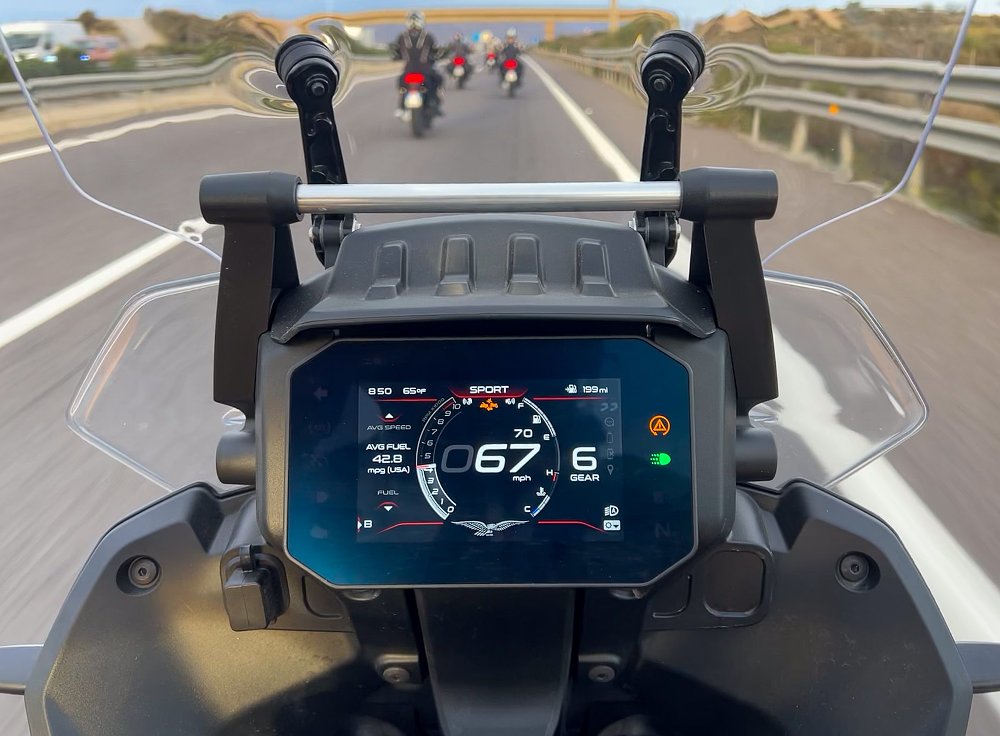
The system eventually makes sense to me if you add the optional Following Cruise Control (FCC). Pricing has not been confirmed yet (in Europe it's roughly 200 Euros), and that means if you want adaptive cruise control then you're stuck spending roughly $1,250. I'd probably just go with the regular cruise control (which works great, despite an annoying flashing light on the dash if you have it on but not engaged) and spend that money on some accessories, instead.
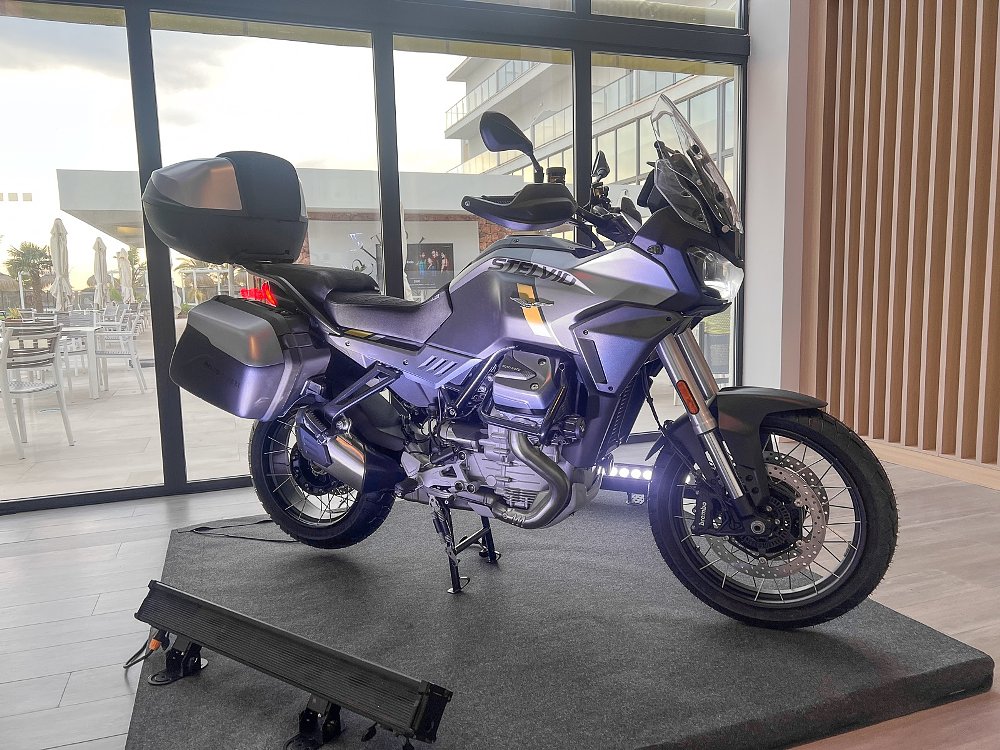
Accessories
My test bike was equipped with optional saddlebags and quickshifter, but Guzzi offers a wide variety of additional options: a rear rack, cylinder-head protection, engine protection, LED auxiliary lighting, tire pressure monitoring system, anti-theft system, center stand, and more. They also sell something I was missing when the temperature dipped into the 40s: heated grips and heated seats with low, normal, and high settings.
Conclusion
Historically, I've found Guzzis to be endearing but I understand they can be an acquired taste, especially to people who are more interested in spec sheets than hitting the road. I'd say that's now officially the past. The Stelvio is the best Moto Guzzi I've ever ridden, and it will absolutely poach customers from other brands. A fantastic pavement pounder that's sportier than it looks, the Stelvio was highly appealing to me because of the handling, torque, and sound. I also think that shaft drive is a big advantage in a touring bike and I adore that it's a little bit different. I did expect something a bit more off-road oriented, but instead this is more of a Mandello on stilts that's been beefed up. It's capable of covering plenty of miles in comfort, but put it in Sport mode and it'll get rowdy if you want it to.
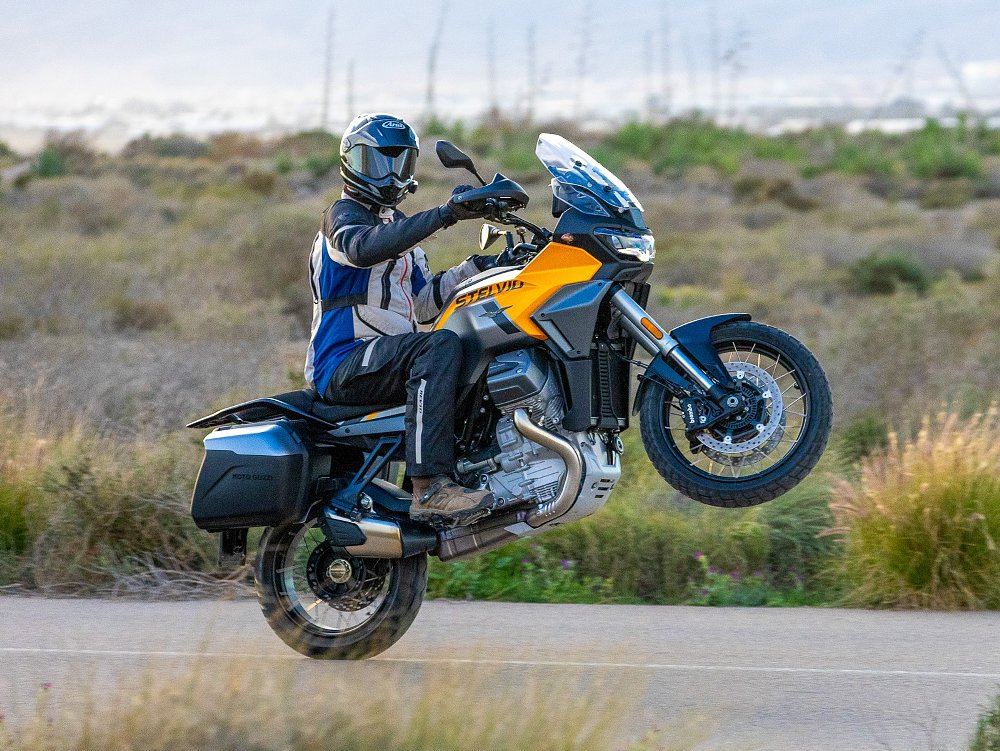
If you don't need to go off-road, the Stelvio offers up a compelling package of Guzzi charm updated with modern technology that doesn't really have a direct competitor. In terms of cylinder layout and shaft final drive, the closest is a BMW R 1300 GS but the Stelvio is significantly cheaper. We only got one day with the bike and I'm sure you'll eventually see comparisons with other ADV bikes once Moto Guzzi gets this in their U.S. press fleet, but to me the main takeaway is that the Stelvio is not just a bike for Guzzi fans. It's a solid contender regardless of the name on the tank, and it deserves your attention if you're in the market.
Let's end this first ride review by going back to the beginning: Piaggio says that the Stelvio is the second of a new range of bikes. After spending a day with the Stelvio and reveling in its engine and handling, I cannot wait to see what they're planning to release next. Here's hoping the Daytona, Griso, or Le Mans make a comeback!
| 2024 MOTO GUZZI STELVIO | |
|---|---|
| Price (MSRP) | $16,390 |
| Engine | 1,042 cc, liquid-cooled, four-valve, transverse V-twin |
|
Transmission, final drive |
Six-speed, shaft |
| Claimed horsepower | 115 @ 8,700 rpm |
| Claimed torque | 77.5 foot-pounds @ 6,750 rpm |
| Frame | Steel tube |
| Front suspension | Sachs 46 mm inverted fork, adjustable for preload and rebound; 6.7 inches of travel |
| Rear suspension | KYB single shock, adjustable for preload and rebound; 6.7 inches of travel |
| Front brake | Brembo four-piston calipers, 320 mm discs, ABS |
| Rear brake | Brembo two-piston caliper, 280 mm disc, ABS |
| Rake, trail | 25.6 degrees, 4.6 inches |
| Wheelbase | 59.8 inches |
| Seat height | 32.7 inches |
| Fuel capacity | 5.5 gallons |
| Tires | Michelin Anakee Adventure, 120/70R19 front, 170/60R17 rear |
| Wet weight | 542 pounds |
| Available | Now (PFF RAS version, Q2 of 2024) |
| Warranty | 24 months |
| More info | motoguzzi.com |

 Membership
Membership

